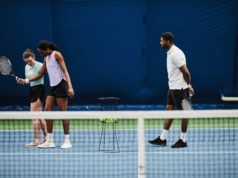By Paul Bartholomai, PSST Tennis Director
After the serve, the second most important shot in tennis is the return of serve. A good return neutralizes the server’s offensive play, forcing them to take more risks and consequently increasing the chances of you gaining command of the point.
In doubles, there are a few keys (tips) for a successful return: the returner’s position when receiving serve, placement of the return, and position after the return.
Return position
A general starting point is on the baseline and one step inside the single sideline. Adjustments will be made depending on the speed and depth of the serve. Strong serves require extra time; therefore, the returner must position themselves further away from the server. On the contrary, weaker serves allow the returner to be more aggressive, so positioning should be closer to the server.
Return placement
The placement of the return is another key factor in gaining control of the point. The three main target areas are cross-court, down the middle, and down the line, with lobbing the service partner as another option. With all of these shots, emphasis should be placed on control (not power) to maintain a higher percentage of accuracy. The singles sideline should be used as a guideline for all returns as to allow for a margin of error.
When returning against a strong server, you should choose a deep cross-court return or lob the server’s partner. Both shots will allow you to regain balance and court positioning. Weaker serves allow the receiving team to gain offensive court positioning.
Position after the return
The last factor to consider is where to go after the return of serve. When returning a strong serve, the receiver generally is in a defensive position; therefore you should assume a position behind the baseline in anticipation of an offensive shot by the serving team. After returning a weaker serve, you should move forward and take position inside the service line. This position allows you to play more offensively and raises your chances of winning the point.
Keeping these ideas in mind will assist in making better choices when selecting a return. No matter which shot is selected the decision should be made before the point starts and should be communicated to your partner. This will allow the receiving team — you — to stay focused on your goal of breaking serve.




